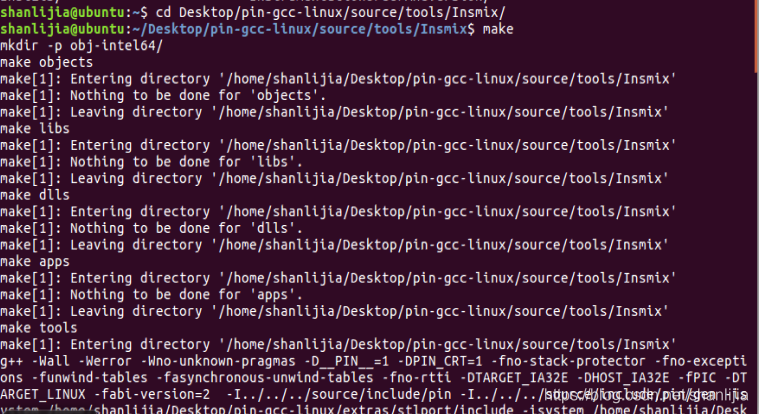测试 Pin
Pin是一个动态的二进制插桩工具。动态意味着它的插桩在运行时执行,而不需要程序的源码
Instruction:一条汇编指令;
Basic blocks:以条件跳转结尾的指令序列;
Trace:以无条件跳转结尾的基本块序列。
运行一个demo,在这个例子insmixde 工具

成功的话会在 source/tools/Insmix/obj-intel64/生成insmix.so文件
然后在pin的根目录执行

结果文件输出在 pin 根目录下,即 insmix.out。

示例 2:统计 instruction 数量(instruction instrumentation)

可以通过添加 option 将分析结果输出到指定文件
pin -t obj-intel64/inscount0.so -o inscount0.log – /bin/ls

示例 3:内存引用追踪(Memory Reference Trace)
有时只希望 instrument 某一类 instructions, 比如 内存操作(读和写)。为此,可以利用 Pin 提供的,用来 classify 和 examine 指令的API。(对所有指令集的基本 API, 和对某个指令集的特殊 API)
本示例通过 examining 指令来选择性的 instrument instruction。Tool对程序引用的内存地址进行了追踪并输出。同时,这里调用 INS_InsertPredicatedCall 而不是 INS_InsertCall 避免在 the predicate 是 false 的情况下,产生对 predicated instructions 的引用。


源代码:
/*
* This file contains an ISA-portable PIN tool for tracing memory accesses.
*/
#include <stdio.h>
#include "pin.H"
FILE * trace;// Print a memory read record打印内存读取记录
VOID RecordMemRead(VOID * ip, VOID * addr){
//打印内存读记录
fprintf(trace,"%p: R %p\n", ip, addr);}// Print a memory write record
VOID RecordMemWrite(VOID * ip, VOID * addr){
fprintf(trace,"%p: W %p\n", ip, addr);}// Is called for every instruction and instruments reads and writes //每条指令和插桩读和写
VOID Instruction(INS ins, VOID *v){
// Instruments memory accesses using a predicated call, i.e.
// the instrumentation is called iff the instruction will actually be executed.
//
// On the IA-32 and Intel(R) 64 architectures conditional moves and REP
// prefixed instructions appear as predicated instructions in Pin.
UINT32 memOperands = INS_MemoryOperandCount(ins);
// Iterate over each memory operand of the instruction.
for (UINT32 memOp = 0; memOp < memOperands; memOp++)
{
if (INS_MemoryOperandIsRead(ins, memOp))
{
//只对 MemOp 做 instrument 并加入 analysis 函数 RecordMemWrite
INS_InsertPredicatedCall(
ins, IPOINT_BEFORE, (AFUNPTR)RecordMemRead,
IARG_INST_PTR,
IARG_MEMORYOP_EA, memOp,
IARG_END);
}
// Note that in some architectures a single memory operand can be
// both read and written (for instance incl (%eax) on IA-32)
// In that case we instrument it once for read and once for write.
if (INS_MemoryOperandIsWritten(ins, memOp))
{
INS_InsertPredicatedCall(
ins, IPOINT_BEFORE, (AFUNPTR)RecordMemWrite,
IARG_INST_PTR,
IARG_MEMORYOP_EA, memOp,
IARG_END);
}
}}
VOID Fini(INT32 code, VOID *v){
fprintf(trace, "#eof\n");
fclose(trace);}/* ===================================================================== *//* Print Help Message *//* ===================================================================== */
INT32 Usage(){
PIN_ERROR( "This Pintool prints a trace of memory addresses\n"
+ KNOB_BASE::StringKnobSummary() + "\n");
return -1;}/* ===================================================================== *//* Main *//* ===================================================================== */int main(int argc, char *argv[]){
if (PIN_Init(argc, argv)) return Usage();
trace = fopen("pinatrace.out", "w");
INS_AddInstrumentFunction(Instruction, 0); //每个 instruction 都会调用
PIN_AddFiniFunction(Fini, 0);
// Never returns
PIN_StartProgram();
return 0;}